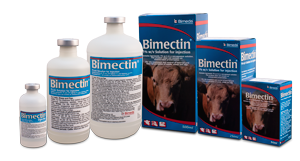PARASITIC DISEASES OF SHEEP
Internal Parasites In Sheep
There are a number of important internal parasites in sheep. Bimectin Injection is licensed for the treatment and control of many of these.
Teladorsagia (Ostertagia) circumcincta
This small brown stomach worm is one of the most economically important gastro-intestinal (abomasal) nematode parasites of sheep in many regions. Its life-cycle is similar to Ostertagiosis in cattle, as are the symptoms.
Haemonchus contortus
The Haemonchus contortus is also known as the Barber’s Pole worm. This parasite is very obvious to the naked eye. A blood sucking parasite, it can cause severe anaemia and death. In acute cases, death can be sudden.
The symptoms of sub-acute infections are similar to those for liver fluke infection, such as bottle jaw. Symptoms of chronic infections are weight loss, poor condition, bottle jaw and a general failure to perform. In contrast to other endo-parasitic infections, diarrhoea is not a symptom of Haemonchus contortus infection and animals are actually more likely to suffer constipation.
Haemonchosis also unusual in that it can cause disease in adults as well as young sheep as they do not develop immunity after exposure.
Haemonchus eggs and larvae do not survive well on pasture over winter so their main way of survival from year to year is via hypobiosis. Haemonchus prefers warmer conditions so it is most commonly associated with warmer climates. However it is now widespread and often occurs in flocks in cool temperate regions now also.
Parasites of The Small Intestine:
Trichostrongylus spp
This parasite causes the black scour traditionally seen in the autumn in store lambs. Now it is frequently encountered earlier in the summer months, causing losses in younger lambs. Conversely, in mild winters, it has been shown to continue with its lifecycle, causing severe disease during the winter and early spring months.
Nematodirus battus
Also known as the thin-necked intestinal worm, Nematodirus battus is a particularly nasty disease in lambs. It will stunt growth and, in a very high number of cases, result in death.
The difficulty with this worm is that it has a different life-cycle to other sheep worms and under certain climatic conditions can strike very quickly, with no warning signs in the lambs this means that sheep farmers have to be on their guard.
The main advantage that Nematodirus has compared with other parasitic worms, is that development to an infective larvae takes place within the egg, meaning that once they hatch in warmer weather they are immediately infective to grazing lambs. In this way, infection passes from one lamb crop to the next year's crop.
Before they can hatch, the eggs have to undergo a period of cold weather followed by warmer temperatures of 10oC or more. If these conditions occur over a short period of time, triggering a mass hatch, the result can be devastating if it coincides with the time when lambs are starting to take in significant amounts of grass.
High risk factors for Nematodirus Battus:
- Lambs grazing pasture that carried lambs the previous spring
- A sudden, late cold snap which is followed by a period of warm weather
- Lambs that are old enough to be eating significant amounts of (6–12 weeks old)
- Groups where there is also likely to be a challenge from Coccidiosis
- Lambs that are under other stresses e.g. triplets, fostered, on young or older ewes
The damage to lambs is done by massive numbers of immature larvae and can be astonishingly rapid. This means that farmers cannot afford to wait for symptoms to appear in their lambs. Unfortunately we cannot rely on faecal egg-count monitoring to time Nematodirus treatments, as the disease is mainly caused by worm larvae, and significant damage can occur before eggs appear in the faeces. Historically seen as a spring problem, Nematodirus Battus is now seen at varying times of the year.

